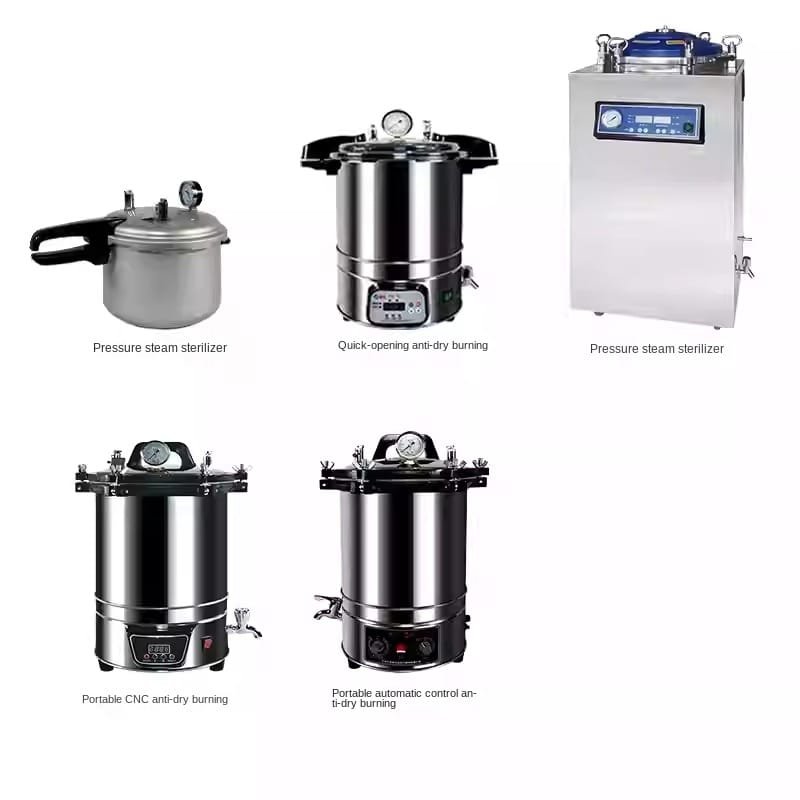

The autoclave sterilization process relies on three key elements: steam, pressure, and high temperature. Steam functions as the main sterilizing agent since it allows better penetration through materials compared to dry heat. The combination of steam and pressure raises temperatures past water’s boiling point which generates a deadly environment for microorganisms.
Chamber: The chamber serves as the enclosed area where items undergo sterilization.
Steam Generator: Produces steam that fills the chamber.
Pressure Control System: Maintains the required pressure for effective sterilization.
Temperature Sensor: The temperature sensor maintains proper heat levels to achieve the required sterilization temperature.
The lethal effects on microorganisms within a steam sterilizer result from combined high temperature and pressure conditions. The standard temperature range for sterilizing materials in an autoclave is between 121°C to 134°C. The microorganism proteins denature and their cell membranes break down at these temperatures which results in their death.
Pre-Vacuum Phase: The chamber is evacuated of air so steam can reach every material inside.
Sterilization Phase: Steam enters the system and stable temperature and pressure conditions persist throughout a specified duration such as 15-20 minutes at 121°C.
Exhaust Phase: The chamber returns to normal pressure after steam is released.
Drying Phase: Items are dried to prevent moisture-related contamination.
The effectiveness of sterilization depends on the precise control of autoclave temperature together with the right time and pressure settings. The autoclave maintains a pressure of 15 psi for 15 to 20 minutes at 121°C. An autoclave should normally operate at 121°C for standard sterilization although specific applications may require higher temperatures.
Gravity Displacement Autoclaves: Ideal for sterilizing liquids and simple instruments.
Vacuum Autoclaves: Suitable for porous materials and complex instruments.
Steam Autoclaves: Steam autoclaves stand as the most frequently used model in hospital and laboratory environments.
Medical facilities utilize autoclaves to sterilize surgical instruments along with medical gowns and equipment.
Laboratories must maintain clean lab equipment and media free of contamination.
The pharmaceutical, food processing industries and others use autoclaves to sterilize their tools and materials.
Sanitize before autoclaving to remove visible debris.
Items should be wrapped using autoclave-safe bags or paper before sterilization.
Routine inspections and maintenance of the autoclave are necessary to verify proper functioning.
Conclusion Anyone who works in sterilization fields must understand how autoclaves function. Autoclaves use steam along with pressure and high temperatures to deliver dependable and powerful sterilization of microorganisms. Professionals in healthcare research and industry sectors must master autoclave sterilization processes to achieve both safety and efficiency.
CTA Discover more about autoclave types and their applications in our next guide: Types of Autoclaves and Their Uses

The autoclaving process serves as an essential sterilization practice utilized across medical, laboratory, and research facilities to protect glassware and instruments through effective sterilization. High-pressure steam eliminates pathogens during this

The autoclaving process serves as an essential sterilization practice utilized across medical, laboratory, and research facilities to protect glassware and instruments through effective sterilization. High-pressure steam eliminates pathogens during this
The autoclaving process serves as an essential sterilization practice utilized across medical, laboratory, and research facilities to protect glassware and instruments through effective sterilization. High-pressure steam eliminates pathogens during this
The autoclaving process serves as an essential sterilization practice utilized across medical, laboratory, and research facilities to protect glassware and instruments through effective sterilization. High-pressure steam eliminates pathogens during this
The autoclaving process serves as an essential sterilization practice utilized across medical, laboratory, and research facilities to protect glassware and instruments through effective sterilization. High-pressure steam eliminates pathogens during this
The autoclaving process serves as an essential sterilization practice utilized across medical, laboratory, and research facilities to protect glassware and instruments through effective sterilization. High-pressure steam eliminates pathogens during this